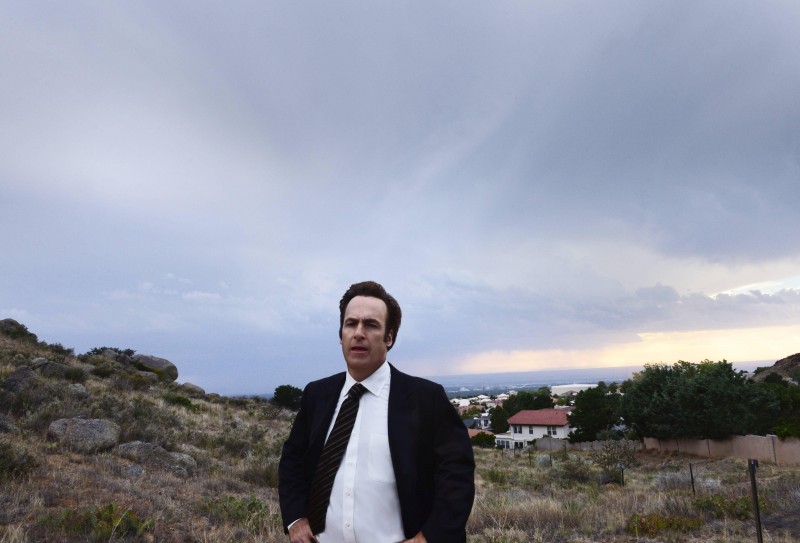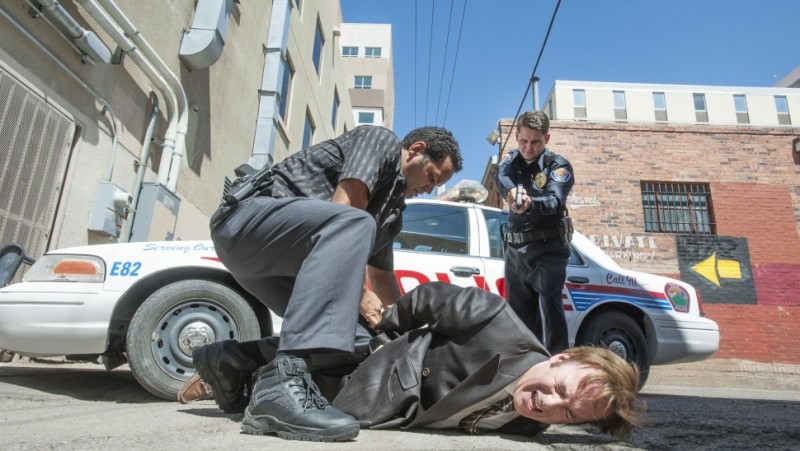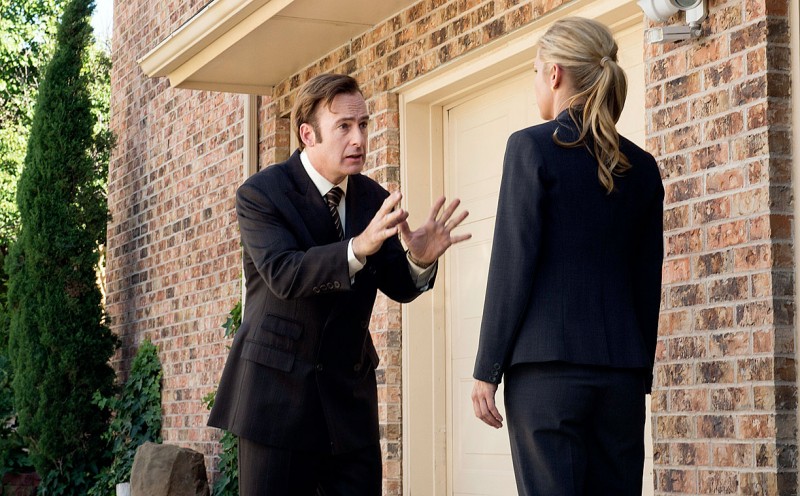Better Call Saul – Nacho Review
""Here's Johnny!""
The first two episodes of Better Call Saul had a lot of heavy lifting to do with introducing us to “Jimmy” and the driving narrative, presenting all the new characters and re-familiarizing with some Breaking Bad faces all the while holding on to the established tone, the mix of intense drama and dark humor that made Breaking Bad so irresistible. They did so with impressive ease, depicting a lived-in world with dramatic style and wonderful performances. “Nacho” continues in that tradition but does so with a much more contemplative pace. The story is slight in this third episode and, even though enough happens, it doesn’t have the narrative agency of the first two hours. Because the introductory episodes had so much ground to cover, they got away with lingering scenes and slow pacing, with “Nacho” the languid quality of the narrative is much more noticeable and at times feels tedious.
When the Kettlemans “Gone Girl” themselves after receiving an awkward but hilarious warning from Jimmy, he is pushed even further into their drama driving him to investigate the family’s disappearance and the role that Nacho might or might not have had in the whole ordeal. It is a simple and straightforward story that, with some clever plotting and writing is portrayed through an array of entertainingly tense, outlandish, and sometimes convoluted but generally entertaining scenes.

The writers aren’t afraid to stretch out a moment, which is evidenced by various sequences like the one in which Jimmy decides to give the Kettlemans a warning call. The moment is built up; we see every step he takes to ensure an anonymous tip: the construction of his MacGyver-ed voice distortion thingy, the car ride to the payphone, the multiple calls he takes before getting the chance to speak (that answering machine message!), the failed attempts at communication, etc.
The sequence escalates and does get tedious, but ultimately pays off by emphasizing the absurdity of it, the heights that Jimmy goes to do this and the perplexed, comic reactions of the Kettlemans before they genuinely grasp the potential danger that could be awaiting them. It also works because the focus is put on Jimmy and his weird sense of duty/desperation/guilt and on the shifty Kettlemans who are so outwardly wholesome and unsuspecting that the idea of them being criminal masterminds (even if they are bumbling criminal masterminds) is greatly amusing. Whenever the show lands on this specific aspect of the plot, it succeeds.

The series also does well with its use of repetition or echoes throughout the narrative, and this episode provides a few examples. Not only throughout a single episode, but also throughout these three initial installments there have recurring motifs and situations that have helped flesh out the characters, aided in establishing the tone and style of the series, and added thematic weight to the story. In “Nacho” we get two pivotal scenes between a layer and his yet-to-be client, both featuring Jimmy in different roles.
The hour opens with Jimmy in jail and visited by his brother Chuck, and later we get almost the same situation but with Jimmy now serving as the council for Nacho. His continuing battle with Mike at the parking booth is an event that has been featured since the first hour as has his spirited (on his part) debates with the prosecuting lawyer (often in the men’s bathroom). These parallels and repetitions add to the sense of tedium or banality that permeates the series (a clear stylistic choice) but also help to inform the character significantly. Though they could come off as irritating and too repetitive, there is always something new being communicated or a different comic angle being explored that makes these scenes worthwhile and ultimately entertaining.
The few moments in which the pacing gets tiresome or the narrative just loses its spark is when he interacts with Kim and/or the people of the McGill firm. There is a bit more of her in this episode and their relationship is intriguingly undefined, but the interactions between the characters are never that compelling to watch. Perhaps because we don’t necessarily know the nature of their relationship there is less investment in their scenes and whenever she appears I just lose interest. I’d much rather be watching Jimmy go against Mike (who was great in this episode) or Nacho or even Chuck.
Despite the lack of interest that those particular scenes generated for me, “Nacho” is an engaging follow up to the impressive “premiere” of
Better Call Saul that advanced the story in somewhat predictable but amusing ways. Bob Odenkirk continues to sell the character and his questionable actions with a remarkable performance that holds everything together and undoubtedly sustains the show.
 Final Thoughts
Final Thoughts
- The show looks absolutely beautiful, with stylish low angles and long shots that emphasize the space and setting and its beautiful cinematography, it is reminiscent of Breaking Bad (with those expansive sky/desert shots) but somehow something entirely its own. That scene in the nail salon at night was quite striking.
- “Sex robot voice”
- Of course the Kettlemans were obnoxiously singing “Bingo” in their clandestine camping trip.
- Though most of the plot points have been fairly predictable (Kettlemans running away, Nacho calling Jimmy, Mike helping him out, the bag full of cash, etc.) they have unfolded in a very entertaining and engaging way.
Pros
- Bob Odenkirk
- Great Comic Moments
- Sublime Visuals
- Mike is a Badass
Cons
- What's up with Kim?
- Some Dull Scenes
- Predictable at Times
 The writers aren’t afraid to stretch out a moment, which is evidenced by various sequences like the one in which Jimmy decides to give the Kettlemans a warning call. The moment is built up; we see every step he takes to ensure an anonymous tip: the construction of his MacGyver-ed voice distortion thingy, the car ride to the payphone, the multiple calls he takes before getting the chance to speak (that answering machine message!), the failed attempts at communication, etc.
The sequence escalates and does get tedious, but ultimately pays off by emphasizing the absurdity of it, the heights that Jimmy goes to do this and the perplexed, comic reactions of the Kettlemans before they genuinely grasp the potential danger that could be awaiting them. It also works because the focus is put on Jimmy and his weird sense of duty/desperation/guilt and on the shifty Kettlemans who are so outwardly wholesome and unsuspecting that the idea of them being criminal masterminds (even if they are bumbling criminal masterminds) is greatly amusing. Whenever the show lands on this specific aspect of the plot, it succeeds.
The writers aren’t afraid to stretch out a moment, which is evidenced by various sequences like the one in which Jimmy decides to give the Kettlemans a warning call. The moment is built up; we see every step he takes to ensure an anonymous tip: the construction of his MacGyver-ed voice distortion thingy, the car ride to the payphone, the multiple calls he takes before getting the chance to speak (that answering machine message!), the failed attempts at communication, etc.
The sequence escalates and does get tedious, but ultimately pays off by emphasizing the absurdity of it, the heights that Jimmy goes to do this and the perplexed, comic reactions of the Kettlemans before they genuinely grasp the potential danger that could be awaiting them. It also works because the focus is put on Jimmy and his weird sense of duty/desperation/guilt and on the shifty Kettlemans who are so outwardly wholesome and unsuspecting that the idea of them being criminal masterminds (even if they are bumbling criminal masterminds) is greatly amusing. Whenever the show lands on this specific aspect of the plot, it succeeds.
 The series also does well with its use of repetition or echoes throughout the narrative, and this episode provides a few examples. Not only throughout a single episode, but also throughout these three initial installments there have recurring motifs and situations that have helped flesh out the characters, aided in establishing the tone and style of the series, and added thematic weight to the story. In “Nacho” we get two pivotal scenes between a layer and his yet-to-be client, both featuring Jimmy in different roles.
The hour opens with Jimmy in jail and visited by his brother Chuck, and later we get almost the same situation but with Jimmy now serving as the council for Nacho. His continuing battle with Mike at the parking booth is an event that has been featured since the first hour as has his spirited (on his part) debates with the prosecuting lawyer (often in the men’s bathroom). These parallels and repetitions add to the sense of tedium or banality that permeates the series (a clear stylistic choice) but also help to inform the character significantly. Though they could come off as irritating and too repetitive, there is always something new being communicated or a different comic angle being explored that makes these scenes worthwhile and ultimately entertaining.
The few moments in which the pacing gets tiresome or the narrative just loses its spark is when he interacts with Kim and/or the people of the McGill firm. There is a bit more of her in this episode and their relationship is intriguingly undefined, but the interactions between the characters are never that compelling to watch. Perhaps because we don’t necessarily know the nature of their relationship there is less investment in their scenes and whenever she appears I just lose interest. I’d much rather be watching Jimmy go against Mike (who was great in this episode) or Nacho or even Chuck.
Despite the lack of interest that those particular scenes generated for me, “Nacho” is an engaging follow up to the impressive “premiere” of Better Call Saul that advanced the story in somewhat predictable but amusing ways. Bob Odenkirk continues to sell the character and his questionable actions with a remarkable performance that holds everything together and undoubtedly sustains the show.
The series also does well with its use of repetition or echoes throughout the narrative, and this episode provides a few examples. Not only throughout a single episode, but also throughout these three initial installments there have recurring motifs and situations that have helped flesh out the characters, aided in establishing the tone and style of the series, and added thematic weight to the story. In “Nacho” we get two pivotal scenes between a layer and his yet-to-be client, both featuring Jimmy in different roles.
The hour opens with Jimmy in jail and visited by his brother Chuck, and later we get almost the same situation but with Jimmy now serving as the council for Nacho. His continuing battle with Mike at the parking booth is an event that has been featured since the first hour as has his spirited (on his part) debates with the prosecuting lawyer (often in the men’s bathroom). These parallels and repetitions add to the sense of tedium or banality that permeates the series (a clear stylistic choice) but also help to inform the character significantly. Though they could come off as irritating and too repetitive, there is always something new being communicated or a different comic angle being explored that makes these scenes worthwhile and ultimately entertaining.
The few moments in which the pacing gets tiresome or the narrative just loses its spark is when he interacts with Kim and/or the people of the McGill firm. There is a bit more of her in this episode and their relationship is intriguingly undefined, but the interactions between the characters are never that compelling to watch. Perhaps because we don’t necessarily know the nature of their relationship there is less investment in their scenes and whenever she appears I just lose interest. I’d much rather be watching Jimmy go against Mike (who was great in this episode) or Nacho or even Chuck.
Despite the lack of interest that those particular scenes generated for me, “Nacho” is an engaging follow up to the impressive “premiere” of Better Call Saul that advanced the story in somewhat predictable but amusing ways. Bob Odenkirk continues to sell the character and his questionable actions with a remarkable performance that holds everything together and undoubtedly sustains the show. Final Thoughts
Final Thoughts